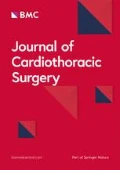Background
Cardiac surgery is looking for new techniques, which are less traumatic with better cosmetic and functional results. The minimally invasive mitral valve in the first procedure is rapidly becoming standard access in several centers around the word. The objective of this report is to show that this new technique can lead to an improved quality of life after surgery and therefore a quicker return to everyday life.
Methods
MFS, 42-year-old female, with history of rheumatic process in childhood. Referred to cardiac surgery in New York Heart Association (NYHA) functional class III and indications of surgical treatment of mitral valve. Reached the right hemi thorax through the 4th right intercostals’ space (RICS) in the nipple-areolar complex after ventilation of the left lung. In the same intercostals’ space, anterior to the axillary middle line, was introduced a 7mm optical trocar to 30 °. At 7th RICS in the anterior axillary line (AAL), we implemented a trocar 7mm which was introduced for insufflation of CO2 and introduction of the soft aspirator. cardiopulmonary bypass (CPB) was established via femoral. In order to maintain ventricular geometry were implanted neochordae PTFE Teflon anchored in the region fibrotic papillary muscle and attached to the mitral annulus in the direction of A1 and A2. The biologic prosthesis n° 29 was implanted with points with braided polyester Teflon in a "U".
Results
The procedure was successfully performed. The CPB time was 110 minutes (min) and aortic clamping of 95 min. The period of mechanical ventilation was 8 hours, bleeding postoperatively of 190ml. In 36 hours the patient was discharged.
Conclusion
Minimally invasive surgery video assisted with periareolar approach for treatment of mitral valve with papillary muscle repositioning is technique with potential to reduce the recovery time with the advantages of a less invasive procedure for the patient.
Author information
Authors and Affiliations
Corresponding author
Rights and permissions
This article is published under an open access license. Please check the 'Copyright Information' section either on this page or in the PDF for details of this license and what re-use is permitted. If your intended use exceeds what is permitted by the license or if you are unable to locate the licence and re-use information, please contact the Rights and Permissions team.
About this article
Cite this article
Abreu, L., Alves, M., Honório, J. et al. Video-assisted surgery via periareolar, mitral valve replacement and papillary muscle relocation with neochordae of PTFE. J Cardiothorac Surg 8 (Suppl 1), P144 (2013). https://doi.org/10.1186/1749-8090-8-S1-P144
Published:
DOI: https://doi.org/10.1186/1749-8090-8-S1-P144

